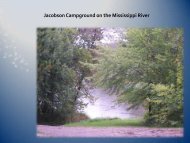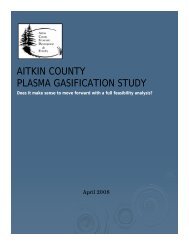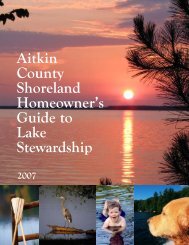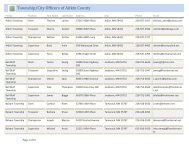Chapter 4: Affected Environment - Aitkin County Government
Chapter 4: Affected Environment - Aitkin County Government
Chapter 4: Affected Environment - Aitkin County Government
- No tags were found...
You also want an ePaper? Increase the reach of your titles
YUMPU automatically turns print PDFs into web optimized ePapers that Google loves.
Unfortunately, many of the changes to natural systems brought about by humaninfluence are undesirable.A synthesis paper (Poff et al. 1997) provides an excellent summary of the topic ofnatural flow of rivers. Several other studies are relevant to the ecology of theHeadwaters lakes, including some that compare Rainy Lake and Namakan Reservoir, anatural lake and an impounded reservoir, both in Voyageurs National Park. The purposeof examining the literature on the effects of impoundment and river regulation is tosummarize the benefits of operating a river system with impoundments in a way thatmore closely follows the natural flow pattern, or hydrograph.Chinese and Egyptians began modifying the flows of rivers thousands of years ago toprovide drinking water supply and agricultural irrigation water. In the age of industrialdevelopment more drastic changes were made for transportation, energy generation,industrial waste disposal and recreation among others.Prior to human intervention, plants and animals lived where their habitat requirementswere met by local conditions. Not all plants and animals would thrive at the same time assome might be better suited to wet years and others to dry but in the long term thedifferent species populated their habitats, interacting with other species and theirenvironment.Different habitats support different groups of species. Headwater streams support adifferent community of life than do larger floodplain rivers. In the Headwaters study area,the lakes range from nutrient-poor acid bogs with few fish species to nutrient-richflowage lakes with many fish species.Animal species tolerate certain ranges of conditions beyond which they cannot survive.Walleyes, for example, are river and lake species that are adapted to flowing water.They can survive cold water in rivers during winter near 0 ºC. Bluegills in contrast, areadapted to living in lakes and need somewhat warmer water in winter.Where conditions are less ideal, species will have broader tolerances that allow them tolive under a wide range of conditions and there will be many individuals of fewer species.Some riverine species have adapted to living in impoundments.Alterations of natural habitats and other human actions have led to the introduction,either accidentally or intentionally, of exotic species of plants or animals which thrive inthe absence of the predators, competition and diseases in their new habitat, imposingstress or outcompeting native species.Streamflow quantity and timing are critical components of water supply, water quality,and the ecological integrity of river systems. Indeed, streamflow, which is stronglycorrelated with many critical physical and chemical characteristics of rivers, such aswater temperature, channel geomorphology (shape and depth), and habitat diversity canbe considered a “master variable” that limits the distribution and abundance of riverinespecies and regulates the ecological integrity of flowing water systems (Poff et al. 1997).The natural flow regime organizes and defines river ecosystems. In rivers, the physicalstructure of the environment and, thus, of the habitat, is defined largely by physicalHeadwaters ROPE Study 66








